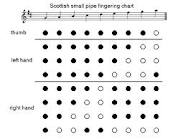Often when we learn an instrument we learn ‘patterns’ for our fingers to use on the instrument, this is an aid to learning an instrument and memorizing tunes. We become accustomed to these patterns and form them into a ‘tradition’ which develops into a certain regional or national style. But, what is important is the ‘sound’ to play the melodies as they should sound and achieving the sound should be more important over technique.
 |
| Finger Chart for the Highland, Scottish Small-pipes, & Border Bagpipes |
I have deviated from the normal ‘tradition’ on the Border pipes, I am adopting a different tradition of fingering the chanter. This mainly concerns the top A note which is fingered traditionally with the bottom hand oxxx and with the top hand xoo o (oxxx xoo o) this is a Highland bagpipe style, which in my opinion is a different style of music to the Lowland piping tradition.
I have been playing Border/Northumbrian melodies using the traditional fingering for a number of years it suits it well, but there are characteristics of the Lowland music which make this fingering of the top A note cumbersome and problematic. There are many ‘jumps’ in Lowland music from a high A down to a lower register, and this can cause a lot of hand ‘waving’ on the chanter (The Highland bagpipe style uses a closed finger technique that lifts multiple fingers off and on the chanter) as the top hand opens so closes the lower hand. It can be messy, especially if the melody demands a quick run or semi-quaver ‘jumps’.
I have been learning the Galician bagpipe for 3 years and they use a different fingering for the high A note, (oxxx xxx o) all fingers closed and only the thumb hole open. It is this technique I have been adopting for the high A on the Border pipes.
At first it was to put the chanter in tune with itself as it was a bit sharp on the top A, so instead of taping or gluing the hole I changed finger technique. Another reason why I used this Galician fingering was I fitted a Galician Bb reed to my Border chanter. I scraped the reed so it was softer to play and could sound a top A in the traditional Lowland fingering, but I found it gave a good high A in the Galician style too.
There are a lot of quaver notes in the Lowland repertoire that ‘jump’ in quick succession e.g. AaAbAcAd. This could mean playing oxxx xoo o for the high A then playing ooxx xxx x for the low ‘b’. I have found it easier to play these notes by using the Galican style oxxx xxx o for the high A then ooxx xxx x for the low ‘b’. this makes life a lot easier.
If you know the fingering style of the Northumbrian Small Pipes then you will know that this style of playing uses a totally closed finger technique, one finger is lifted off then replaces before the other is lifted. So jumping from a high to a low note is not a problem. This Galician high A position is similar in style to the Northumbrian as only the thumb is removed while the rest of the fingers stay on the chanter.
Of course there is no evidence that this finger style was used in the tradition of Border piping….but there is no evidence to prove it was not used either. The music certainly allows for an easy way of playing these ‘jumps’. and the Galician high A is one solution. In practise, I tend to mix these 2 finger styles, depending on the melody, some runs require it others do not.
In the Border/Northumbrian tradition at least there has always been a healthy innovation, without it the Northumbrian Small Pipes would never have evolved. It is easy to imagine these innovations coming about by influences from outside of the Borders through the numerous ports, commerce and migrants/visitors/travellers, as well as closer to home though journeymen, after-all tunes travelled and it is said that the Northumbrian Small Pipes were influenced by the French musette. .
There are numerous bagpipes which use the ‘closed fingering’ style as the Border pipes, some more closed than others…but this style is not wholly a Scottish fingering technique. The Asturian Gaita uses a crossed/closed fingering not unlike the Border pipes. Both are conical bored chanters and a 2nd octave can be reached by the same technique of the Galician high A fingering position.


